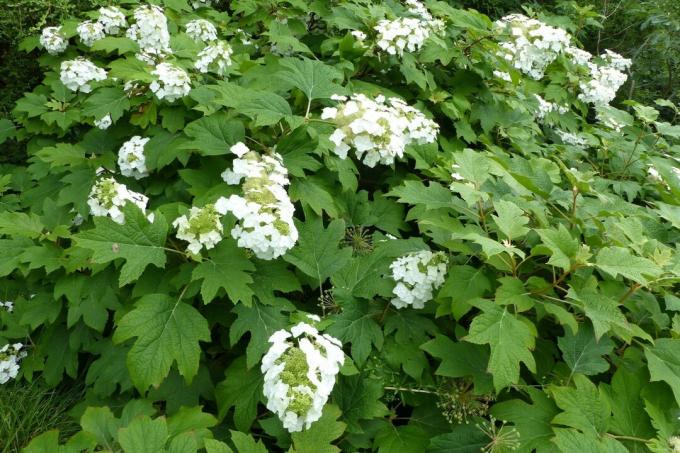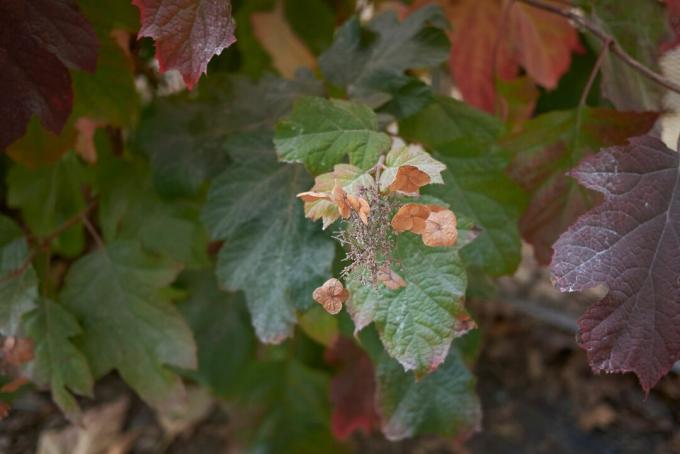The oak-leaved hydrangea, or oak hydrangea, inspires with its eponymous oak-leaf-shaped leaves and white flowers. We will show you what to consider when planting and caring for this type of hydrangea.

The oak-leaved hydrangea is a special eye-catcher in the garden with its lush panicles of flowers and characteristic oak-leaf-shaped leaves. The decorative leaves, which are reminiscent of the shape of the American red oak, take on a pretty color in autumn.
contents
- Oak-leaved hydrangea: origin, characteristics and flowering period
- Oak-leaved hydrangea: the most beautiful varieties
- Planting oak hydrangea: location and timing
-
Caring for the oak-leaved hydrangea
- Water and fertilize oak hydrangea
- Cut oak-leaved hydrangea
- Hibernate oak-leaved hydrangeas
- Propagate oak-leaved hydrangeas
Oak-leaved hydrangea: origin, characteristics and flowering period
The oak-leaved hydrangea (
Hydrangea quercifolia), also called oak hydrangea, is a species from the hydrangea family (Hydrangeaceae). It originally comes from the southeastern United States and thrives there in dry forests and steppes.The oak-leaved hydrangea grows as an upright, 1 to 2 m high shrub. It also becomes about 1 to 2 m wide, sometimes even wider due to the formation of runners. Its flowers open between July and September, which are arranged in conical to rounded panicles about 15 cm in size. They are made up of sterile pseudo-flowers and fertile flowers. The pseudo-flowers usually have 4 to 5 petals and are 3 to 4 cm in size. At the beginning of flowering they are pure white, later they turn reddish. The fertile flowers lie close together between the pseudo-flowers and are less noticeable. While the sterile flowers are used to attract insects, it is the fertile flowers that provide nourishment for pollinators with pollen and nectar.

The special feature of the oak-leaved hydrangea, which also gives it its name, is the striking shape of its leaves. The 10 to 20 cm long and 15 cm wide leaves are pinnate and lobed and are very reminiscent of the foliage of the American red oak (Quercus rubra), especially since they also turn red, dark red or even purple in autumn. In summer the semi-evergreen foliage is deep green on the top and gray-green on the underside. The top is wrinkled, the underside is hairy tomentose. The shoots also initially have a reddish felt, but this decreases with age.
Oak-leaved hydrangea: the most beautiful varieties
The varieties of the oak-leaved hydrangea differ in their flower structure, autumn color and height. The following varieties are extremely ornamental and will particularly enrich your garden:
The variety Hydrangea quercifolia ‘Alice‘ becomes 1.5 to 1.8 m high and 0.5 to 1 m wide. It forms lush white and later pale pink flower panicles in large numbers. The foliage appears at first in a strong green and contrasts wonderfully with the white flowers. Later the leaves take on a pretty autumn color.
The ‘Snowflake‘ variety forms double pseudo-flowers and is therefore a special eye-catcher. It becomes 0.8 to 1.5 m high and 0.6 to 1.2 m wide. The large, oak-shaped leaves turn reddish to bronze in color in autumn.

The ‘Ruby Slippers®‘ variety grows a little more compact. It reaches a height of 1 to 1.5 m. In the course of flowering, their flower panicles initially take on a pink and later a dark red color.
Planting oak hydrangea: location and timing
Oak-leaved hydrangeas can be planted all year round. However, the prerequisite is that no frosts are to be expected on the days around the planting.
The hydrangeas prefer a sunny to partially shaded and protected location in the garden or on the balcony. The soil should be fresh to moist and humus. In locations that are too nutrient-rich, the shoots only mature to a lesser extent before frost, so that they can be more frequently affected by frost damage. Large amounts of fresh compost before planting are therefore not appropriate with the oak leaf hydrangea.
The oak-leaved hydrangea is sensitive to waterlogging, which is why a drainage layer, for example made of gravel, should be introduced in the case of compacted or very heavy soil. Such a layer is also absolutely necessary for pot plantings.
Compared to other Hydrangea species, which are very sensitive to a high lime content in the soil, the oak-leaved hydrangea is lime-tolerant. The soil pH value of oak hydrangeas can also be slightly higher than, for example, garden hydrangeas. It should be in the neutral to weakly acidic range. Nevertheless, the oak-leaved hydrangea avoids lime and should therefore not be limed under any circumstances.

When you've found the right spot, it's time to plant the oak-leaved hydrangea. Dig a sufficiently large planting hole in the flowerbed. It should be about twice the size of the root ball. If the soil in your garden doesn't meet the above requirements, then you can too Mix a third with sand to increase substrate permeability and mature compost mix in. Alternatively, you can buy peat-free potting soil and mix it with sand in the above ratio to get the optimal substrate. For example, ours is suitable for this Plantura organic universal soil ideal - it contains all the important nutrients in a balanced ratio. The pH value is 6.1 to 6.9 in the weakly acidic to neutral range and is therefore suitable for the oak-leaved hydrangea.
Put a small part of the substrate back into the planting hole and place the plant ball in the middle of it. By slightly loosening the root ball with your hands or a spade, you are making small injuries to the roots that encourage the roots to grow and branch. Then the planting hole is completely filled with substrate, the soil is pressed down and generously watered. If you want to plant several hydrangeas next to each other, you should keep a planting distance of about 2 meters.
Tip: Freshly planted hydrangeas benefit greatly from a watering edge that they can easily model from excess soil after planting. This is regularly filled with water and prevents the irrigation water from running away unused.
The oak-leaved hydrangea is also suitable as a potted plant for the balcony or terrace. Choose a sufficiently large planter with a drainage hole so that excess water can run off when watering and no waterlogging can occur. To avoid waterlogging, potsherds should be placed on the bottom of the vessel.
Caring for the oak-leaved hydrangea
As with all hydrangea species, a good water supply is the basic requirement for the successful development of hydrangea plants. Young plants in particular need to be watered daily. Apart from the occasional application of fertilizer and the maintenance pruning, however, no special maintenance measures are necessary.
Water and fertilize oak hydrangea
Newly planted hydrangeas need to be watered daily so that they can grow well. In the dry, hot phases of summer you should also water oak-leaved hydrangeas once and in pots maybe even twice a day. Even if oak hydrangeas are more lime-tolerant than others Hydrangea-Types, you should preferably use low-lime rainwater. Oak-leaved hydrangeas love cool, moist soil. The easiest way to achieve this is through a layer of mulch made from leaves or bark. Such a layer serves as protection against evaporation and keeps the moisture in the soil longer.
Tip: Water your hydrangeas in the morning and / or in the evening, when the sun is not yet so strong, so that the water is used efficiently and does not evaporate immediately.
In particular, hydrangeas in pots should be fertilized annually and preferably in spring so that they can start the growing season well. Our Plantura organic hydrangea fertilizer optimal. With its long-term effect, it reliably supplies your hydrangeas with all the necessary nutrients and prevents typical deficiency symptoms and diseases. Work in the fertilizer flat and, if necessary, cover it with a layer of mulch of leaves or something similar so that it begins to work quickly.
Tip: If you fertilize too late, plants are susceptible to frost, as it prevents the shoots from maturing or hardening at the end of the vegetation period. It is therefore recommended to fertilize for the last time in May / June. You can find more information in our special article on the Fertilizing hydrangeas.
Cut oak-leaved hydrangea
Oak-leaved hydrangeas have a beautiful, upright habit. They can be cut if necessary, but the plants develop splendidly even without pruning. Only the shoots and flower panicles that have frozen or dried up over the winter should be removed in spring. Use clean secateurs to cut off the dried flowers just above the new flower buds.
Hibernate oak-leaved hydrangeas
Oak-leaved hydrangeas are hardy with us. When buying, it is best to make sure that you choose well-hardened plants from specialist shops. Plants from nurseries are often preferable to plants from garden centers. Well-hardened hydrangeas are hardy down to -23 ° C, provided they are not in the cold and damp winter wind. Even young shoots survive temperatures down to -10 ° C undamaged. If you still want to be on the safe side, you can cover the ground around the hydrangea's plant base with leaves or pine branches. In this way, their roots are not damaged by the effects of frost. Hydrangeas in the pot are somewhat more endangered due to the small volume of soil: it can happen that the entire pot freezes through. Therefore, in late autumn, you should cover the planter with plant fleece or jute sacks and, if necessary, place it in a sheltered place, such as a house wall.

Propagate oak-leaved hydrangeas
Oak-leaved hydrangeas can be propagated from cuttings. These are cut in early summer. Cut off annual, flowerless shoots from the plant and divide them into pieces about 10 to 15 cm long. The leaves are then removed except for the upper pair of leaves and the cuttings are placed at least 5 cm deep in planters filled with seed compost. Our nutrient-poor, for example, is suitable for this Plantura organic herb & seed compostthat mixed with at least a third of sand forms the right substrate for the cuttings. The substrate should be moistened daily. In a bright place without direct sunlight and at a temperature of around 15 ° C, the cuttings can take root and grow into new young hydrangea plants.
If you would like to find out more about other hydrangea species, you can read everything about them in our special article Panicle hydrangea Experienced.
